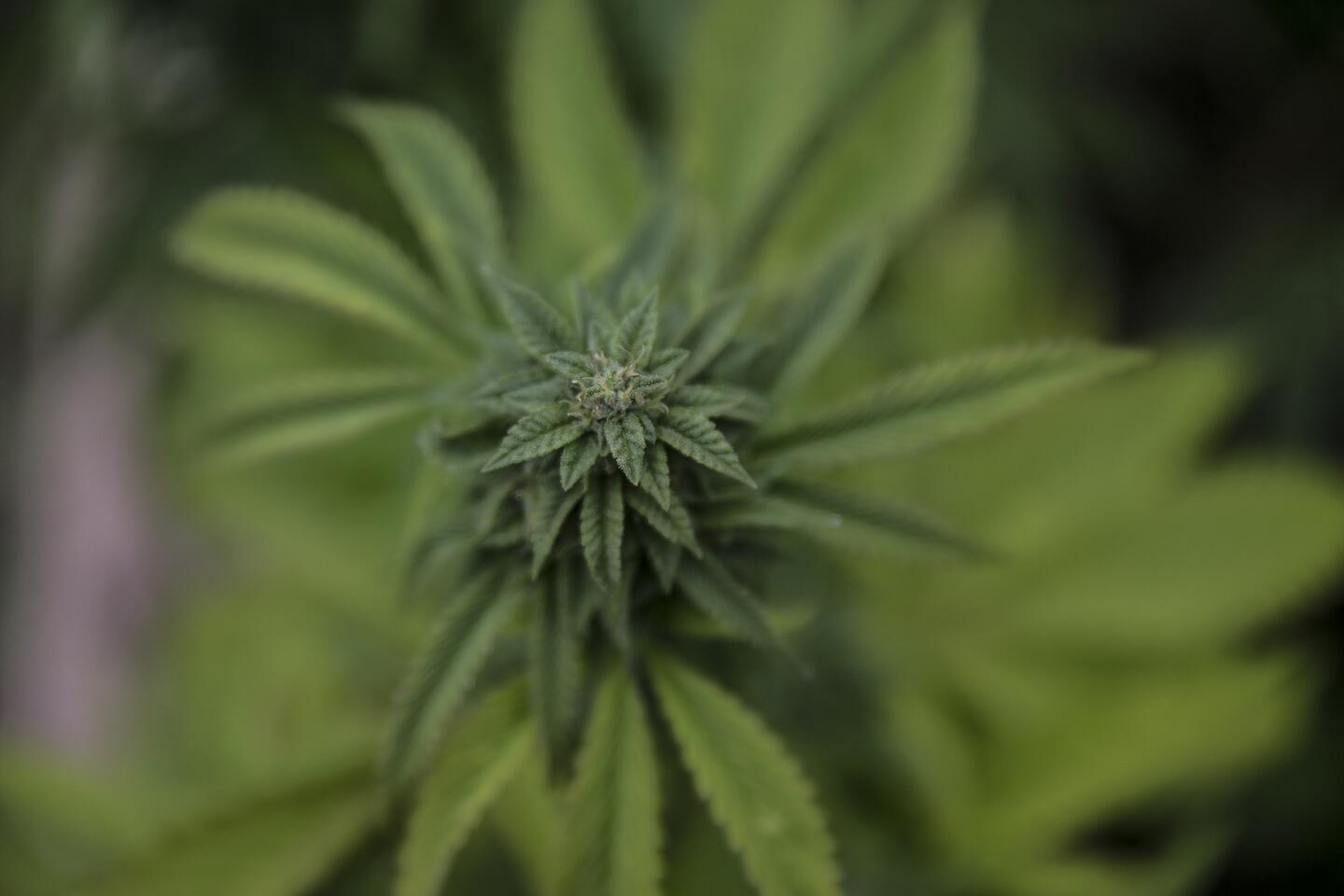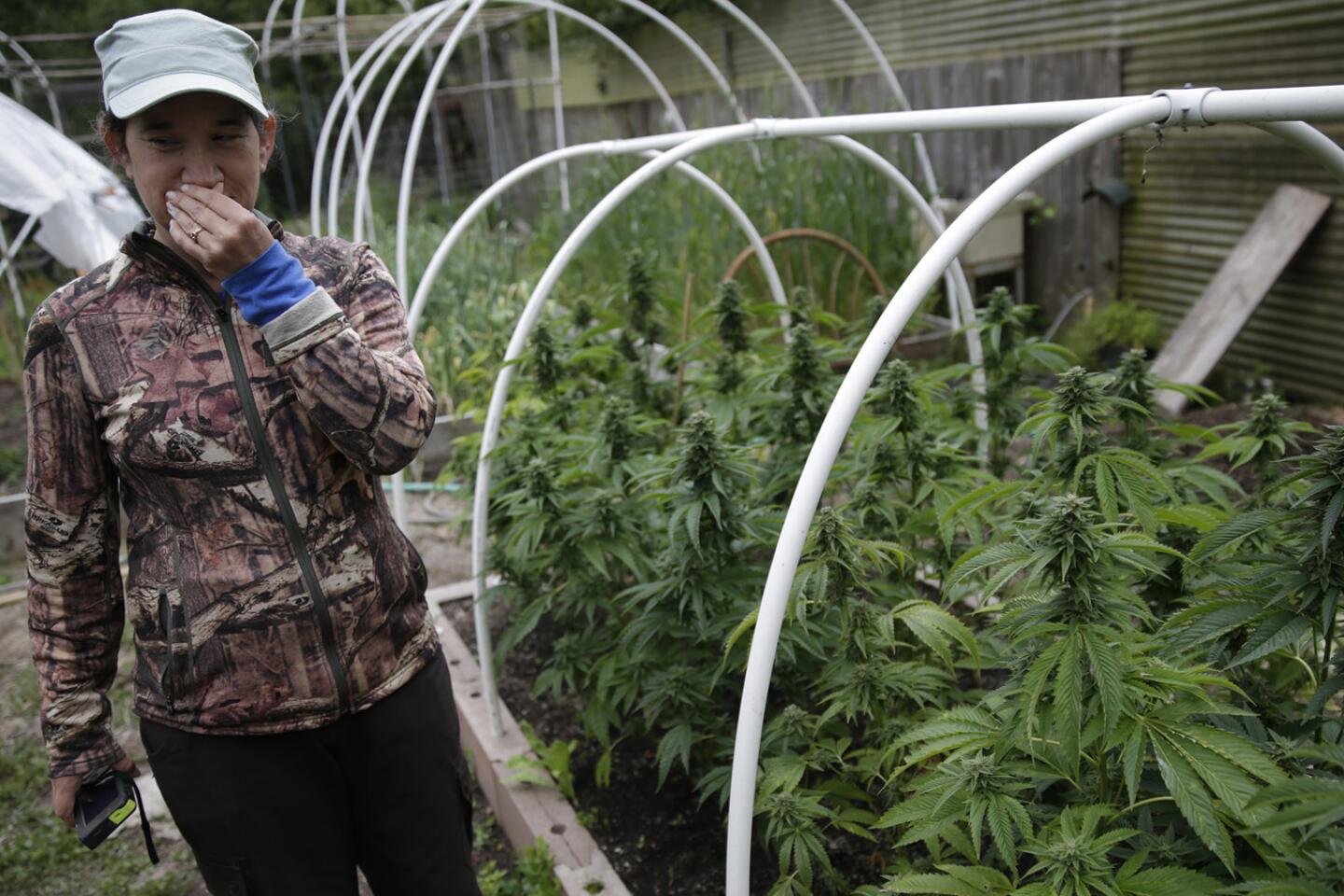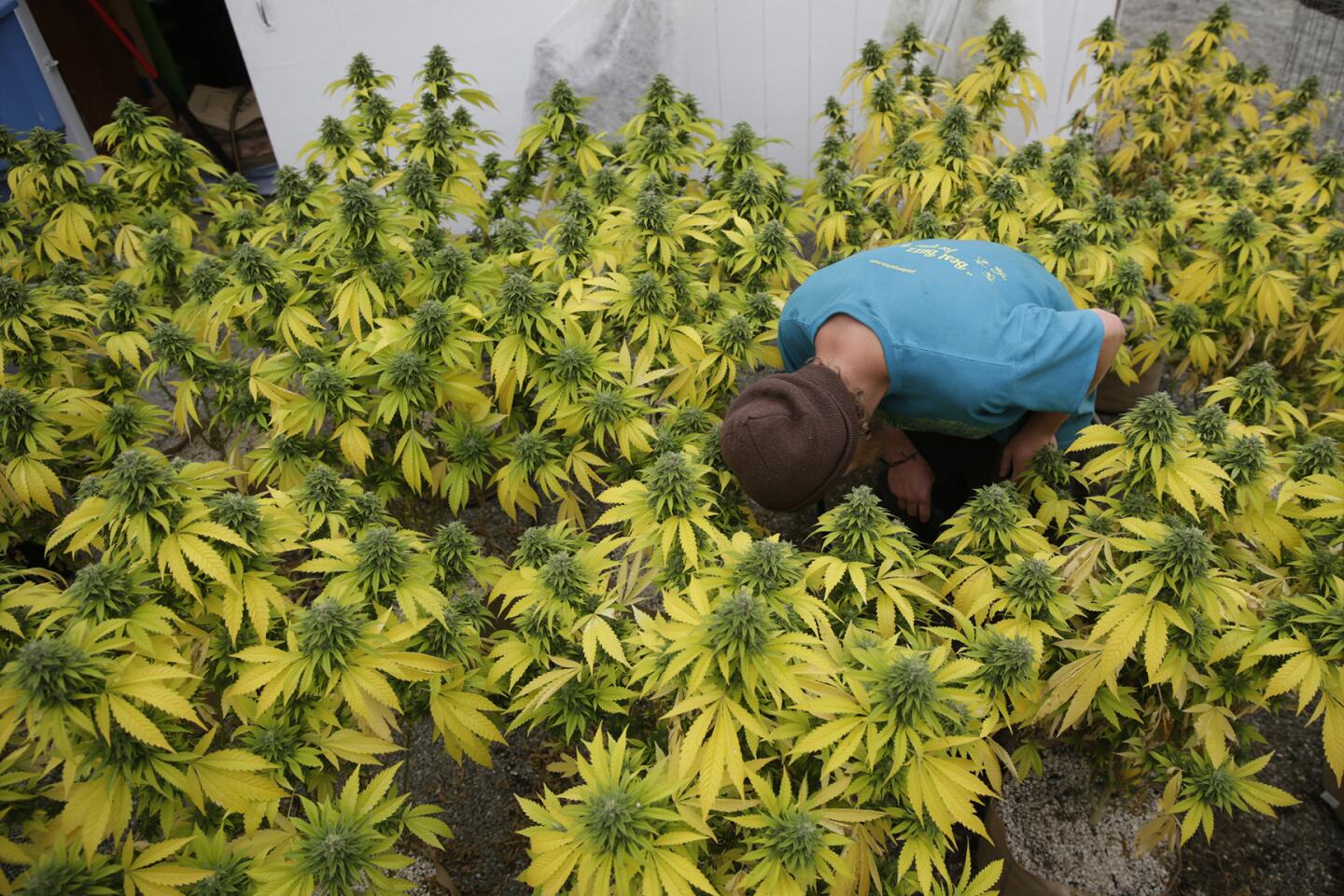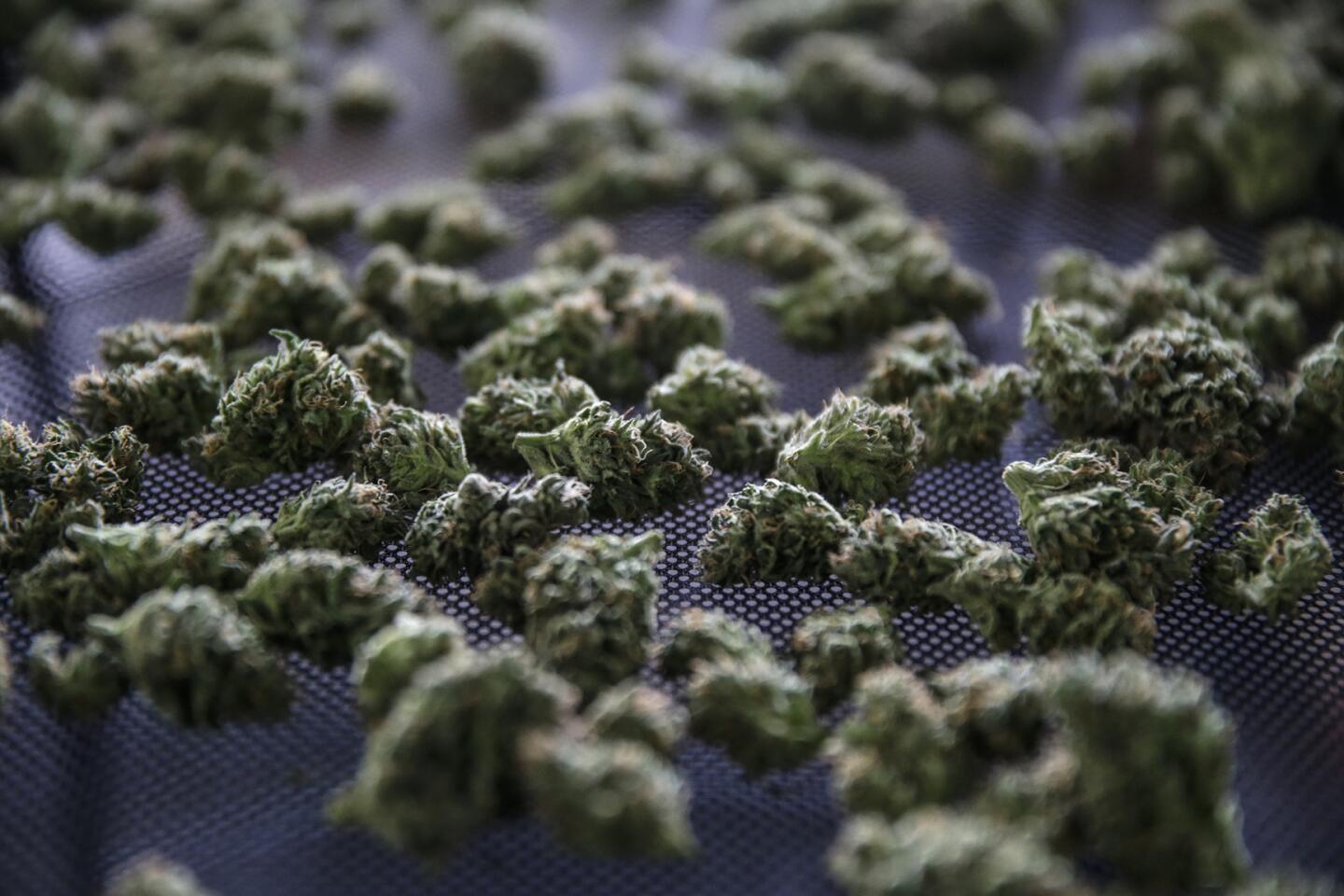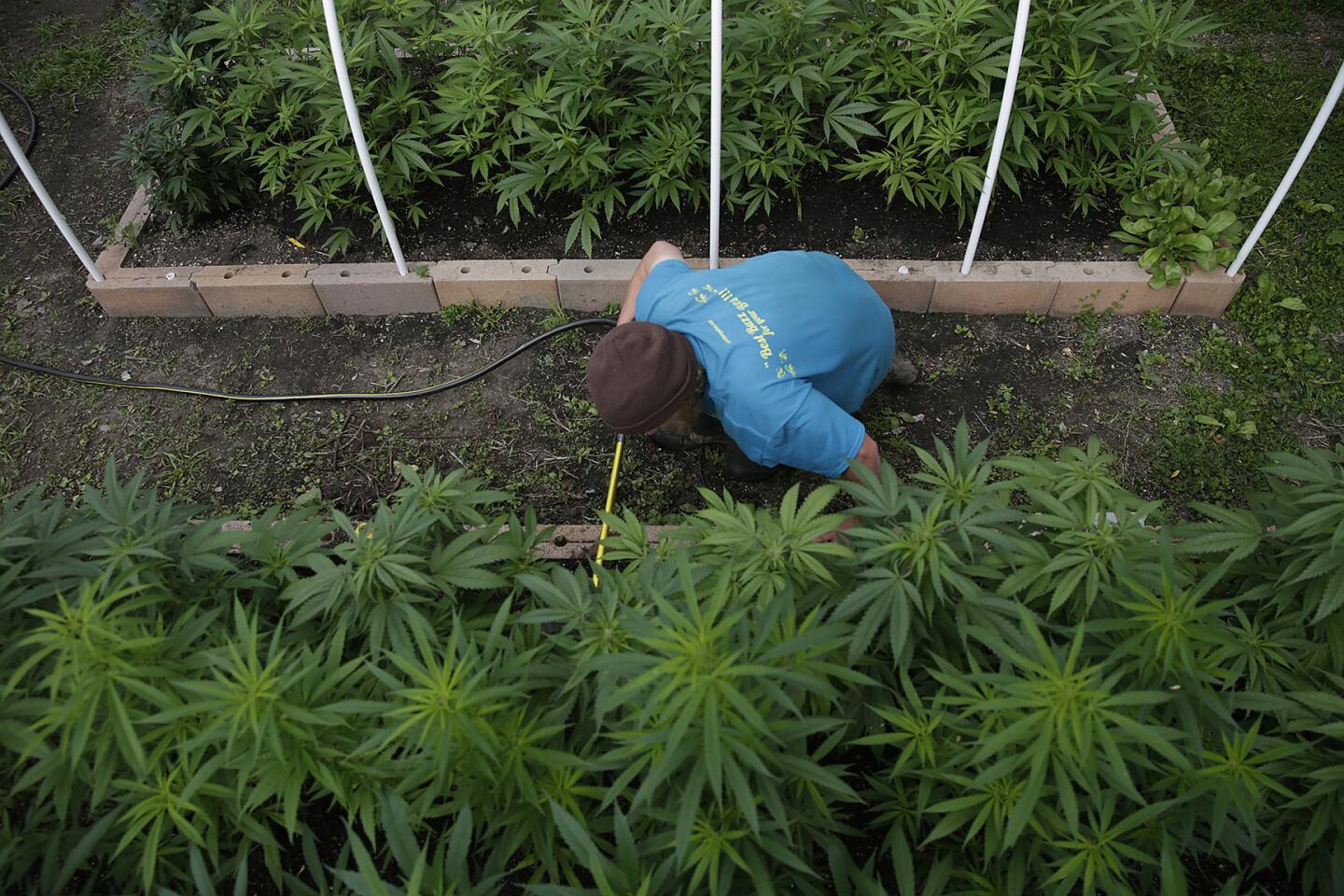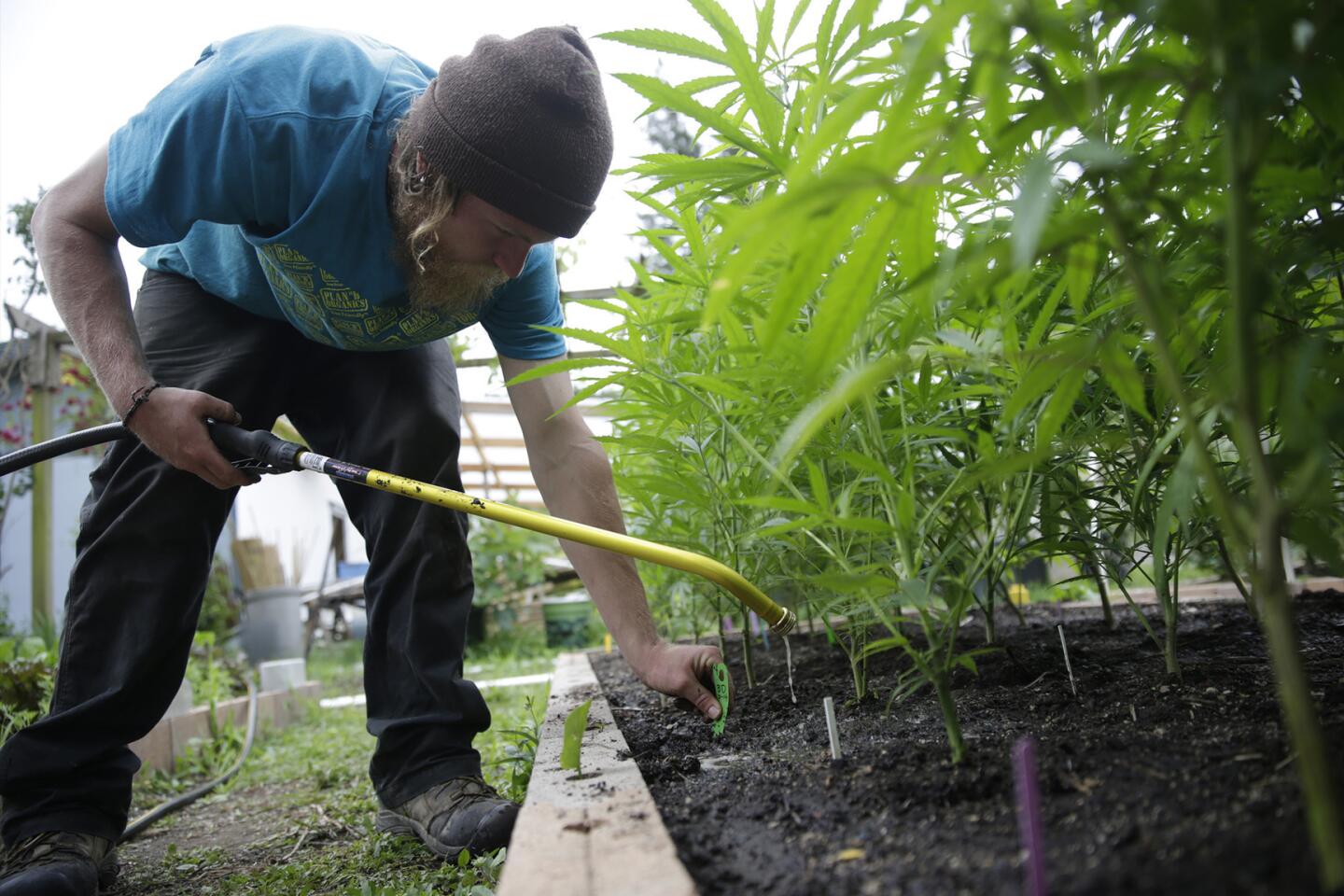North Coast marijuana growers fear a takeover by ‘Big Alcohol’
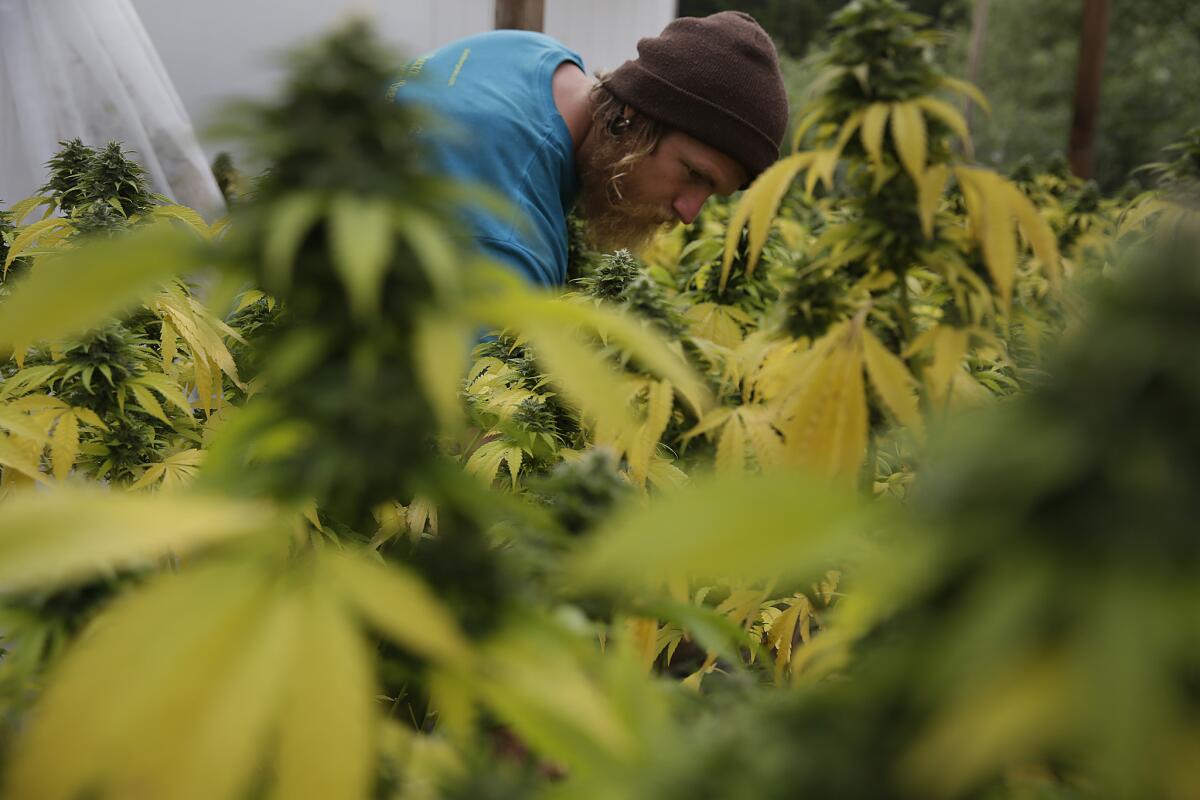
- Share via
For the Humboldt farmers, Sonoma County’s subterranean tasting rooms and Tuscan affectations offered a glimpse into a rarefied realm of legal intoxicants.
The marijuana growers had driven south from redwood country to the oak and grass hills to take part in an event called “The Women of Wine & Cannabis,” a chance to visit boutique wineries and learn about appellations and branding in the $200-billion retail alcohol market.
But as they sipped wine on a vine-covered terrace of the Mayacama Golf Club that evening, some of them began to see an insidious subtext to the affair.
The moneyed establishment was shouldering into the marijuana game, legislating the system to its favor, and the small growers who had built the industry had better accept the new model or get bulldozed by it.
Ted Simpkins — a retired executive from the nation’s biggest alcohol distributor, Southern Wine & Spirits — stood up to welcome the growers and proceeded to give what they characterized as a gruff lecture about who were going to be the “winners and losers” when new medical marijuana regulations take effect in the next two years.
See the most-read stories this hour >>
Accompanied by Assemblyman Jim Wood (D-Healdsburg), one of the authors of the new cannabis legislation, Simpkins explained that they would not be able to sell their weed directly to retailers; they would sell to distributors.
And Simpkins happened to own a distribution company that was lobbying heavily in Sacramento to craft the law the way he wanted.
Some of the women liked his pitch, heartened that such a big shot was interested in their businesses. But others suddenly saw that someone with this much money posed a new threat to their scruffy livelihoods.

Sunboldt Farms, a small family business run by Sunshine and Eric Johnston in Redcrest, Calif., grows sustainable cannabis.
To them, the elderly man — gravel-voiced, sporting a prep-school blue blazer and horse bit loafers — was sending a clear message: Sign up now and hand over a cut of your sales or get pushed out of the market by the new Southern Wine & Spirits of weed.
“We had the sudden feeling we were in the belly of the beast,” Sunshine Johnston, a grower in Redcrest, said of that warm evening in August.
Two of the women grew so upset they left the party, trudging two miles down a rural road.
Since voters first legalized medical marijuana with Proposition 215 in 1996, competing interests have tried to take control of the chaotic market.
Bills or citizen initiatives that would have clarified the rules of the business or make recreational use legal have been stymied, partially because the divided industry never came together to endorse any one of them.
Growers have long complained that dispensary owners held all the power because they could get licenses and operate openly, while the cultivators who grew the product and drove it to market were widely seen as outlaws.
As late as July 2014, the seven-member board of the main growers association in the state consisted of four retail operators and only one full-time grower. No one wanted to publicly state he or she grew pot for a living.
“The growers association was run by dispensaries,” said Hezekiah Allen, executive director of the group, now called the California Growers Assn. and under grower control. “We were sharecroppers. So yes, there is a lot of bad blood.”
While Colorado built its regulated industry largely from scratch, California — the cradle of the marijuana movement — is struggling to redesign a makeshift system that people have been cobbling together, mostly underground, for half a century.
For some veteran growers in the North Coast, the requirement to sell to distributors looked like the corporate seed to their destruction. They would operate like the alcohol industry, where Budweiser and Miller have ruled since Prohibition, where beer, bourbon or wine makers can sell their products only through state-licensed brokers, who then sell to stores.
While prices for marijuana have sunk to all-time lows, new players would be taking a bite out of increasingly thin margins.
To many farmers in Humboldt and Mendocino counties, this was not just an attack on profits, but on the backwoods hamlets that have long operated like autonomous states — where marijuana growers and their money build local schools, volunteer fire stations, community centers, even a regional radio station.
Some, like Johnston, 43, who grew up in the Mattole Valley in Southern Humboldt and went to a pot-funded school, have decided to fight to survive in the industry by working to brand their fabled terroir.
She is trying to trademark her brand name, “Sunboldt” — because it’s grown in the sun, not under lights — and working on logos and packaging.
Join the conversation on Facebook >>
Her property, among fields and blackberry thickets on a silty terrace of the Eel River, is the vintage “small family farm” she says. On this spring morning, up the canyon walls that embrace her home, crows wheel in a mist that clings to the redwoods, alders and firs.
Her plot sits inland of the summer fog belt, a perfect spot to grow. She and her husband, Eric, are spending the day building light-deprivation tents, which signal the plants to flower early, and feeding the bigger plants with worm compost tea.
She knows the wine business; she is a part-time broker for family wineries in Oregon. And she knows how hard it is to get product on the shelves in an industry dominated by Southern Wine and other big distributors.
“I want to get my brand in early and get the shelf space,” she said. “The next few years are going to be rough and tumble.”
Other cultivators see hope in the new model, and some have signed up with Simpkins’ company, River Wellness, hoping it will give them more power to set prices with dispensaries, which are known for retail mark-ups well above 100%.
“I’m not sure of another industry that allowed retail to make the rules,” said Patrick Murphy, a Willow Creek grower who signed on with River.
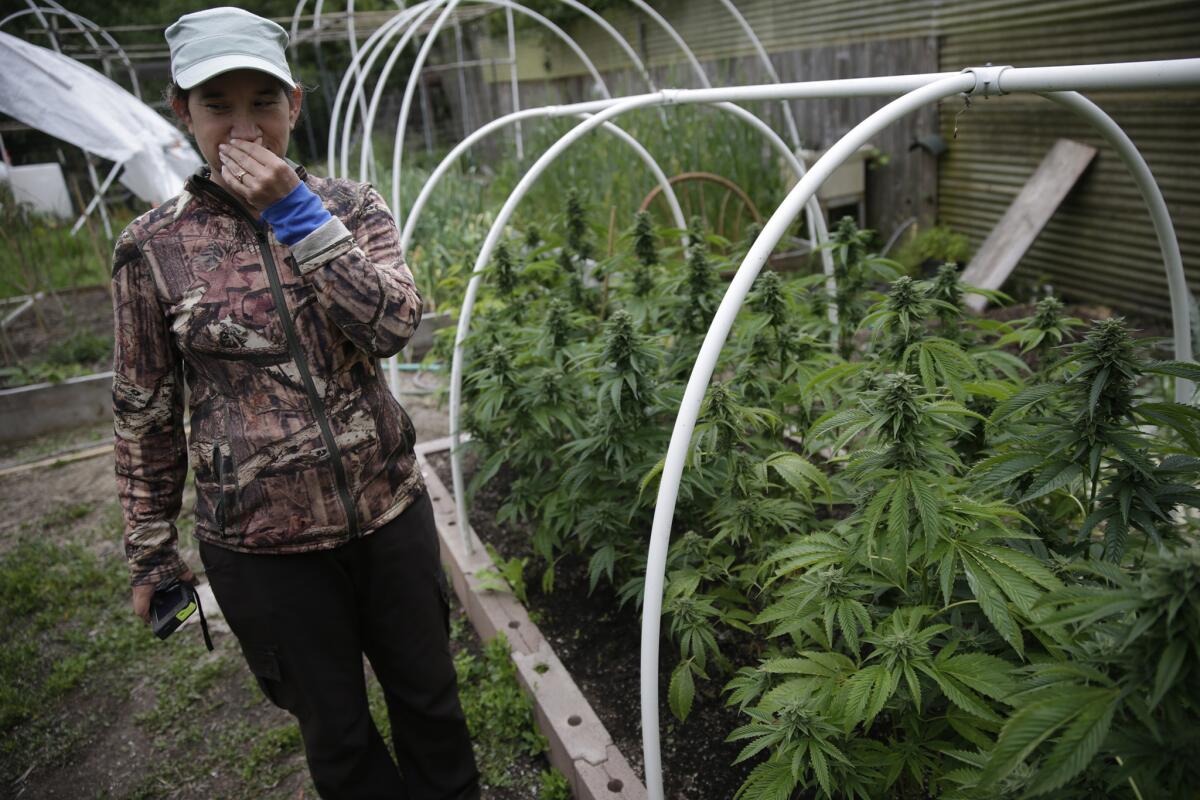
He said it is common for North Coast growers to agree on a price point with a Los Angeles dispensary, then drive 10-plus hours only to be told the number had dropped. “It’s a typical bait-and-switch. What am I going to do? Stay in a hotel and look for other dispensaries?”
He said he’s happy to leave distribution to the professionals.
“Look, there’s a fair amount of paranoia out here, and that paranoia is well-earned. It’s a leap of faith for farmers to enter into a system that has treated them unfairly in the past. ... You’re talking about 50 years of sacrifice, of loss of life, families being separated by incarceration, financial ruin.”
But he says he does not fear that a small number of distributors will come to monopolize the entire market. “I get about 10 emails a day from new distribution companies opening up.”
Under the new law, California will start issuing licenses for distributors, growers, retailers, testing facilities and others in 2018. The distributor would be required to have the marijuana or infused product analyzed at a laboratory for potency and contaminants, such as mold and pesticides.
River had been working since early 2015, lobbying key legislators and regulators in Sacramento, to push this model through to the governor’s desk.
It hired the high power firm of Mercury Public Affairs, led by former Assembly speaker Fabian Nunez, paying $82,500 over nine months, according to state records.
It also hired lobbyist Jason Bryant, a friend of Assemblyman Wood’s from when they both worked for the California Dental Association, paying him $52,000 by the end of March, the records show. (That was nearly $10,000 more than Bryant earned from his next-largest client — the California Growers Assn.)
------------
FOR THE RECORD
May 27, 12:13 p.m.: An earlier version of this article said that River Wellness and the California Growers Assn. were the only employers of lobbyist Jason Bryant. They were the two highest-paying of nine employers.
------------
Simpkins and his company contributed $6,000 to Wood’s campaign, and over $5,000 to the campaign of Fiona Ma, a commissioner on the Bureau of Equalization.
Simpkins, 75, started his career at Southern Wine & Spirits in 1971 and took over the lucrative California division of the company in 1983. Over the next 27 years, he took annual sales from $100 million to over $2.5 billion, according to his company bio.
In the past five years with Southern, he earned more than $39 million, court records show. He jumped to a competitor in 2010, serving as executive vice president and general manager of Young’s Market Company, until his retirement in 2014.
“When I retired, someone asked me if I should distribute cannabis,” Simpkins said in an interview. “I didn’t know anything about the industry. I began to look into it. I thought [Proposition] 215 was one of the worst laws I ever read.”
Simpkins said there was no legal way to transport the pot. “Dispensaries were doing good, but growers were going to jail.”
In February 2015, Simpkins attended a meeting in Sacramento with Allen, of the growers association, and members of the Board of Equalization, to talk about a distribution model. Simpkins tried to persuade Allen that having a tier of independent distributors inserted into the supply chain would empower growers by forcing retailers to negotiate better pricing and shelf placement.
Allen said he initially didn’t buy it.
“Here you got essentially big business, everything we didn’t want in this industry, telling us, ‘Hey, it’s going to be great.’ ”
In the northern marijuana belt, known as the Emerald Triangle, the specter of a Big Alcohol or Big Tobacco swooping in to take over hangs like a distant fog off the coast. To conspiracists, Simpkins’ career at Southern Wine blew it to shore in a cold gust of reality.
He said he pushed for the alcohol distribution model with Ma, the commissioner at the Board of Equalization, which was grappling with the best ways to collect taxes from the industry. “The wine model, I certainly brought it up to Fiona at the BOE: ‘Why don’t you follow the wine model?’ ”
Simpkins went to Humboldt County and met with marijuana growers, and he says he became convinced he could help them.
“I’m retired,” he recalled. “I don’t need to do this. I did really fall in love with the people of Humboldt.”
By last May, Allen said the growers association had decided that it could not keep big capital out of the new scheme and that the alcohol model, long considered in policy circles in Sacramento, was the only way law enforcement would back it.
Narcotics officers saw it as a way to avoid diversion of marijuana to the black market. And the Board of Equalization supported it, arguing that it would create a manageable “choke point” in the supply chain, with a smaller number of entities to perform audits and collect taxes.
The language was added to Assembly Bill 266, one of three bills that would created the new rules, at the end of June, three months before Gov. Jerry Brown signed it into law.
Allen says that anyone caught off guard by the provision wasn’t paying attention and that the current uproar is being fueled by big dispensary owners, who might lose some of their profits.
Nate Bradley, executive director of the California Cannabis Industry Assn., a group formed with the stated purpose of uniting the industry, disagrees. He said most of the industry did not learn of the rule until after it was added, and he fears only large-scale growers and manufacturers will be able to make a living after big distributors takes their cut.
“The distributors have created an extra step that does nothing but create profit for them,” he said. “We are concerned it will close down small farmers and other small businesses.”
The state has not worked out how many distribution licenses will be issued, or what the requirements will be to get one. In February, Brown appointed Lori Ajax, a top official from the department of Alcoholic Beverage Control, to be the first chief of the new Bureau of Medical Marijuana Regulation.
Ajax has until 2018 to flesh out all the rules not explicitly spelled out in the legislation. Adding a potential layer of chaos is a well-funded ballot initiative to legalize recreational use of marijuana, which does not require independent distributors.
And on the North Coast, where many growers illegally graded roads and diverted streams for water, they are facing new rules that could individually cost tens of thousands of dollars in improvements to grow sites, and up to $10,000 a year in permits.
Since Google Earth has made pot farms easy to spot, even in the most remote areas, the growers simply can’t hide anymore.
“There is no way the cottage industry can pay these fees,” said Michael McLaren, a grower in Trinidad. “Now we got distributors coming in. They want 30%. The little guys are going to get mowed.”
------------FOR THE RECORD: Marijuana growers: In the May 27 Section A, an article about marijuana growers misspelled the first name of Dillon Turner, a worker at Sunboldt Farms in Redcrest, Calif., as Dylan.------------
MORE ON MARIJUANA:
If California legalizes marijuana, consumption will likely increase. But is that a bad thing?
L.A. County extends medical marijuana growing ban one month
This California desert town is experiencing a marijuana boom
Not everyone is high on idea of legalizing marijuana for recreational use (VIDEO)
More to Read
Sign up for Essential California
The most important California stories and recommendations in your inbox every morning.
You may occasionally receive promotional content from the Los Angeles Times.
